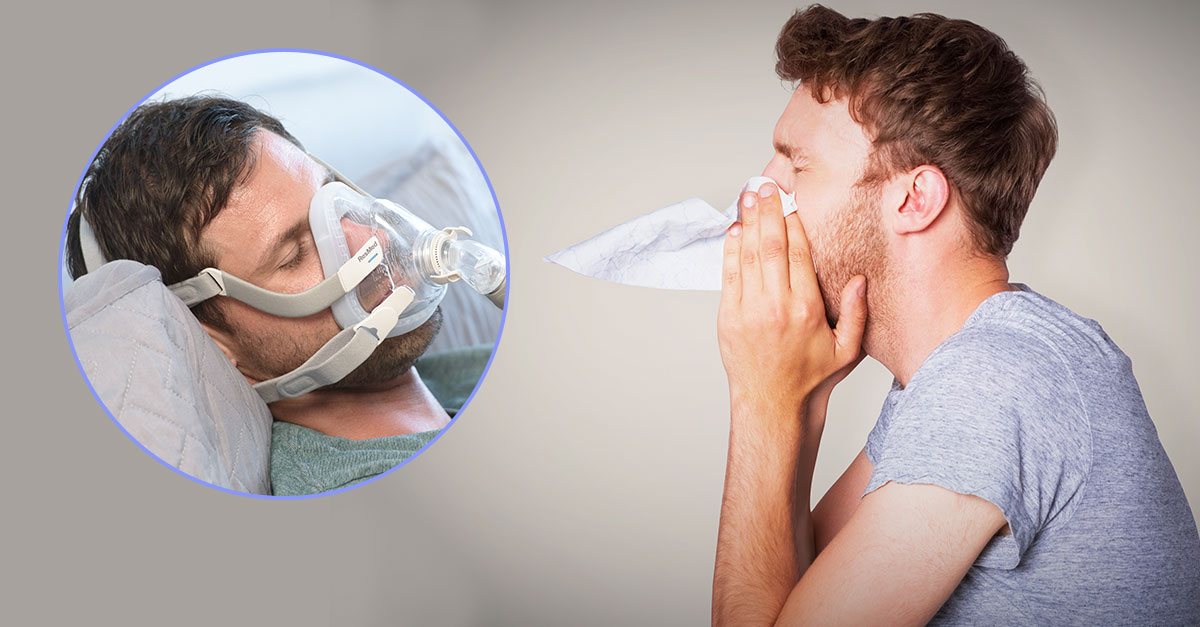You’ve been using your nasal or nasal pillow mask for several months and receiving the amazing benefits of CPAP therapy. Then one day, you run into a big problem. You catch a cold.
This is a dilemma most CPAP users will face at some point. How do you continue using your much-needed CPAP machine when you have a serious case of sinus congestion?
Fortunately, we have a number of tips and tricks that can help. Not only will you be able to make it through the dreaded cold and flu season without having to give up your CPAP therapy, you won’t lose those sick days you’ve been saving up!
Here are six ways CPAP users can manage sinus congestion:
1. Use a full face mask
Since your nose will likely be out of commission for at least a week while you battle a cold, the best course of action is to purchase a full face CPAP mask. This will let you continue enjoying the benefits of CPAP therapy while you wait for your congestion to go away.
If you are a nasal or nasal pillow user who’s looking for a more minimal style, try either the Amara View or the DreamWear Full Face. These are great alternatives and will be more similar to the style you’re accustomed to.
2. Use an auto-titrating CPAP machine
Many CPAP users still rely on traditional machines that provide a single level of air pressure throughout the night. However, this may not be ideal when you’re feeling under the weather. For that reason, you may want to look into an auto CPAP machine.
These machines automatically adjust the air pressure being delivered during the night. This continuous adjustment will make your therapy more comfortable when you’re sick.
3. Use a heated humidifier
The biggest problem with using your CPAP machine while sick is the buildup of phlegm, dryness, and swollen membranes in your nose. One way to deal with this is by using a heated humidifier.
A heated humidifier pumps warm, moist air through your CPAP, helping you restore the moisture levels to your nasal passages. This will make it easier for you to sleep comfortably and to continue using your CPAP machine.
4. Disinfect your supplies with a CPAP Sanitizer
 Using a CPAP with congestion can be a vicious cycle when caused by a cold or the flu virus. After your body works all day to fight the sickness, you end up putting your germ infected mask back on that night and reintroducing yourself to the problem.
Using a CPAP with congestion can be a vicious cycle when caused by a cold or the flu virus. After your body works all day to fight the sickness, you end up putting your germ infected mask back on that night and reintroducing yourself to the problem.
There are three different automated CPAP sanitizers that kill 99% of germs and bacteria and require no handwashing, soap or water. The SoClean, VirtuClean, or Lumin are all great sanitizing options, while sick, and also act as a fantastic preventative measure to ensure that that you don’t get sick in the first place.
5. Sleep in an elevated position
Often, CPAP users that are also back sleepers have the most trouble dealing with a cold. Nasal congestion is often much more uncomfortable for back sleepers which makes it difficult to utilize your CPAP machine.
One way around this is to sleep in an elevated position. By simply putting a few pillows under your neck, you’ll decrease the amount of mucus buildup. If this doesn’t help, you could also try sleeping on your side.
6. Try a nasal aid or other decongestant
Nasal decongestants are a good way to combat nighttime stuffiness. For instance, Nasal Aid is a strip that goes over the bridge of the nose and helps expand your nasal passages during sleep. This makes it easier to utilize a nasal or nasal pillow mask.
Users can also take advantage of over-the-counter nasal spray or antihistamines sprays.
















